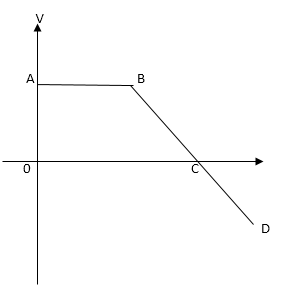
Describe the motion as shown by the following velocity time graphs.
A)

B)

Answer
220.2k+ views
Hint: The slope of the velocity-time graph gives the acceleration of the body. When the line describing motion of the particle is parallel to the X-axis, the velocity of the particle is considered to be 0. The motion of the body can be defined using acceleration, velocity and the displacement of the body. The slope of any velocity-time graph is the acceleration and the area of the graph is the displacement.
Complete step by step answer:
(A)

As we can see from the above figure, the point A is in the positive Y axis that means, the velocity of the particle is positive.
We know, Slope of the velocity-time graph gives us the acceleration. In the region AB, we see a slope which is decreasing, therefore, we can say the acceleration is in the negative direction, also termed as deceleration.When the line describing motion of the particle is parallel to the X-axis, the velocity of the particle is considered to be 0. Thus, the region BC is constant zero velocity.
Further, in region CD, we observe a negative slope, that means the body again decelerates at a constant rate.
(B)

In the above figure, we can observe the following:
Region AB has a constant velocity of some magnitude, as the line of motion is parallel to the x axis.
Region BC, it is seen that the slope of the curve proceeds towards the negative axis, as it has a negative slope. Thus the body decelerates.
In the region CD, the body continues moving further towards the negative axis, due to constant deceleration.
Note: When velocity of a particle is 0, the curve in velocity-time graph coincides with the X axis. Acceleration refers to the increase in speed of a body with respect to time and deceleration refers to decrease in speed of a body with respect to time. Deceleration is also referred to as negative acceleration.
Complete step by step answer:
(A)

As we can see from the above figure, the point A is in the positive Y axis that means, the velocity of the particle is positive.
We know, Slope of the velocity-time graph gives us the acceleration. In the region AB, we see a slope which is decreasing, therefore, we can say the acceleration is in the negative direction, also termed as deceleration.When the line describing motion of the particle is parallel to the X-axis, the velocity of the particle is considered to be 0. Thus, the region BC is constant zero velocity.
Further, in region CD, we observe a negative slope, that means the body again decelerates at a constant rate.
(B)

In the above figure, we can observe the following:
Region AB has a constant velocity of some magnitude, as the line of motion is parallel to the x axis.
Region BC, it is seen that the slope of the curve proceeds towards the negative axis, as it has a negative slope. Thus the body decelerates.
In the region CD, the body continues moving further towards the negative axis, due to constant deceleration.
Note: When velocity of a particle is 0, the curve in velocity-time graph coincides with the X axis. Acceleration refers to the increase in speed of a body with respect to time and deceleration refers to decrease in speed of a body with respect to time. Deceleration is also referred to as negative acceleration.
Recently Updated Pages
Keplers second law is a consequence of A Conservation class 11 physics JEE_Main

How do you apply the correction due to zero error class 11 physics JEE_Main

Water waves are A Longitudinal B Transverse C Both class 11 physics JEE_Main

In a car lift compressed air exerts a force F1 on a class 11 physics JEE_Main

A particle moves in a straight line according to the class 11 physics JEE_MAIN

A circular hole of radius dfracR4 is made in a thin class 11 physics JEE_Main

Trending doubts
JEE Main 2026: Application Form Open, Exam Dates, Syllabus, Eligibility & Question Papers

Understanding Uniform Acceleration in Physics

Derivation of Equation of Trajectory Explained for Students

Hybridisation in Chemistry – Concept, Types & Applications

Understanding the Angle of Deviation in a Prism

How to Convert a Galvanometer into an Ammeter or Voltmeter

Other Pages
Thermodynamics Class 11 Physics Chapter 11 CBSE Notes - 2025-26

JEE Advanced Marks vs Ranks 2025: Understanding Category-wise Qualifying Marks and Previous Year Cut-offs

Units And Measurements Class 11 Physics Chapter 1 CBSE Notes - 2025-26

NCERT Solutions For Class 11 Physics Chapter 8 Mechanical Properties Of Solids

Motion in a Straight Line Class 11 Physics Chapter 2 CBSE Notes - 2025-26

Laws of Motion Class 11 Physics Chapter 4 CBSE Notes - 2025-26




